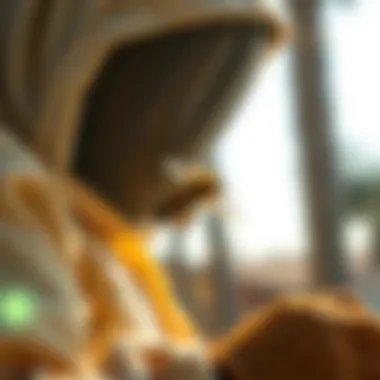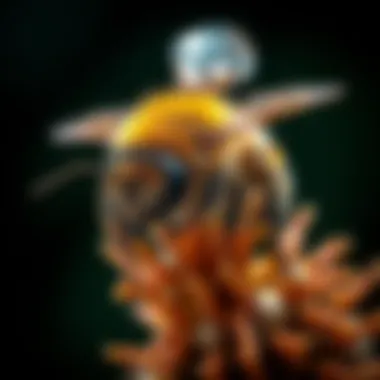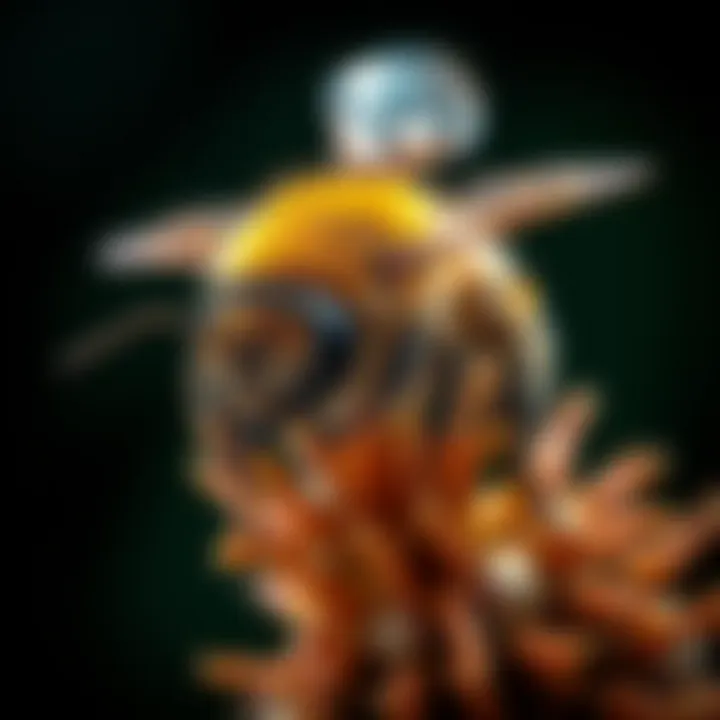Comprehensive Guide to Bee Removal in Santa Clarita


Intro
In the sun-kissed landscapes of Santa Clarita, one encounters a diverse range of bee species harmoniously buzzing about. While these little creatures play a pivotal role in pollination and maintaining our local ecosystem, there are times when they cross the line into our homes and gardens. This article serves as a crucial guide, providing insights into bee removal tailored for the Santa Clarita homeowner. From identifying the pesky intruders to exploring eco-friendly removal techniques, it aims to enlighten and empower those who encounter these buzzing neighbors.
Understanding the local bee populations is vital not only for successful pest management but also for fostering a sense of responsibility towards our environment. The guide seeks to balance the needs of homeowners with the preservation of these essential insects, ensuring that any intervention respects the ecological fabric of our area. We'll dive into preventative measures that can keep bees at bay while also looking out for their well-being, mapping out a detailed route for effective management of any potential infestations.
Through this article, you’ll learn that engaging with bee removal is not just about getting rid of a nuisance; it’s about understanding a broader perspective on environmental stewardship and community health. Whether you're a resident with a garden or just someone looking to enjoy a peaceful home environment, this guide offers valuable knowledge and practical solutions to bee-related challenges.
Prolusion to Bee Removal
Bee removal is a significant topic that touches upon various aspects of our lives, particularly for homeowners and those who care about the environment. In areas like Santa Clarita, the presence of bees can be both beneficial and concerning. Understanding bee removal is essential to managing these industrious insects while maintaining ecological balance.
Bees play a critical role in pollinating plants, helping to sustain the food supply and the broader ecosystem. However, when bees invade homes, they can pose safety risks. Their nests, often found in eaves, attics, or gardens, can lead to stings and allergic reactions. Thus, it becomes necessary to consider effective removal strategies.
This article aims at educating readers on the intricacies of bee removal, highlighting vital information that balances the coexistence of bees and human safety. It covers not just the reasons for removal, but also the eco-friendly alternatives and professional services available in Santa Clarita.
As we journey through this guide, we’ll dive into the types of bees present, signs of infestation, DIY methods, and when to call in professionals. Understanding these facets makes it clear that bee removal is not just a matter of pest control, but rather an informed approach to managing our living spaces harmoniously with nature.
Understanding the Importance of Bees in the Ecosystem
Maintaining the health of our environment heavily relies on bees. These tiny creatures are among the most efficient pollinators, affecting over 70 of the top 100 crops that feed the world. They increase yields of fruits, nuts, and vegetables, which are pivotal for domestic and commercial food systems. With such a vast influence on our agricultural landscape, losing bees can disturb entire ecosystems.
Bees contribute to biodiversity by aiding the reproduction of flowering plants. Many plants depend exclusively on specific bee species for fertilization. Without these furry pollinators, many habitats would struggle to maintain their plant diversity, leading to a cascading effect on species that rely on these plants for survival.
Why Bee Removal Is Necessary
While recognizing the benefits bees bring, there are instances when their presence becomes a concern. When bees decide to nest close to living spaces, problems arise. Stings can be dangerous, especially for those allergic to bee venom. Moreover, large colonies can lead to property damage. For example, honey bees can create extensive wax and honeycomb structures that compromise the structural integrity of buildings.
In addition, unfettered bee populations can result in competition for resources, leading to potential declines in local bee numbers. Thus, timely and effective bee removal is crucial—not just for homeowner safety, but for the overall health of local ecosystems. It is essential to handle bee removal with care to ensure ecological balance is preserved.
"Understanding the dual nature of bees can provide clarity on why their removal is not just necessary, but should be approached thoughtfully."
By grasping the balancing act between appreciating their ecological value and addressing removal needs, individuals can make informed decisions that ultimately benefit both people and the environment.
Common Bee Species Found in Santa Clarita
Understanding the types of bees that populate Santa Clarita is essential for effective management and removal strategies. Different species have unique behaviors, nesting preferences, and roles in the ecosystem, which means the approach to handling them can vary significantly. Awareness of the common bee species not only aids in recognizing when intervention is needed but also informs homeowners about how to cohabitate or manage these creatures responsibly. Realizing that bees contribute to the environment by pollinating plants helps to foster a more appreciative attitude towards these pollinators, even when removal becomes necessary.
Honey Bees
Honey bees occupy a significant niche in the bee world, renowned for their role in pollination and honey production. These bees are social and live in colonies that can range from a few thousand to tens of thousands of individuals. They often build their hives in man-made structures or natural cavities. Homeowners usually notice honey bees due to their buzzing activity and organized flight patterns around their hive.
When engaging with honey bees, it's crucial to recognize their generally docile nature when not provoked. Nevertheless, their sting can be painful and occasionally lead to allergic reactions. Controlling their population may require professional help especially when a hive is established in a difficult-to-reach area. Given that honey bees are declining in numbers globally, it's often ideal to explore relocation rather than extermination, which can help preserve local bee populations.
Bumble Bees
Bumble bees are often seen as the friendly neighborhood bees, with their distinctive fuzzy bodies and vibrant color patterns. Unlike honey bees, they tend to have smaller colonies, usually not exceeding a few hundred bees. Bumble bees usually nest in the ground, often utilizing abandoned rodent burrows or clumps of grass. They are excellent pollinators, particularly of crops like tomatoes and peppers, making their presence beneficial for local gardens.
Their temperament can be a bit more ferocious than honey bees; they will defend their nests aggressively if they feel threatened. Homeowners might want to reconsider removal if bumble bees are nesting in an inconspicuous location, given their importance to the local ecosystem and agricultural activities.
Solitary Bees


Solitary bees encompass a variety of species, with the most notable being mason bees and leafcutter bees. These bees do not live in colonies but instead lay eggs in individual nests, often constructed in hollow stems, soil, or even human-made bee hotels. Solitary bees are incredibly efficient pollinators, particularly for native plants, and often tend to be less aggressive than social bees, making them safer neighbors around residential areas.
Because they operate independently, solitary bees play a crucial role in maintaining the local biodiversity. They rarely sting unless directly handled. Homeowners seeking to attract these beneficial pollinators can do so by providing suitable nesting sites and an array of flowering plants. Engaging in practices that foster the wellbeing of solitary bees integrates nature into residential spaces effectively.
As you can see, knowing about these common bee species enhances the overall understanding of their importance to our lives and environment.
"Understanding the types of bees in your area is the first step towards effective management that respects ecological balance."
By recognizing their unique characteristics, homeowners can develop better strategies for coexistence or removal when needed.
Recognizing Bee Infestations
In the landscape of home ownership, being able to identify a bee infestation is crucial. By spotting the signs sooner rather than later, homeowners can prevent more serious issues down the road. Los Angeles County, where Santa Clarita lies, sees its fair share of bees, so understanding how to recognize their presence and activity can save a lot of trouble. Additionally, residents can help keep these crucial pollinators safe while also ensuring their own comfort and safety.
Signs of Bee Activity
Recognizing signs of bee activity is the first step in addressing an infestation. Here are some key indicators:
- Buzzing Sounds: One of the most unmistakable signs is the unmistakable buzz. If you hear a constant buzzing noise near certain areas of your home, it's likely that bees are nearby.
- Visual Sightings: Spotting bees entering or exiting from crevices or holes in your walls, eaves, or roof is often an obvious indication of a nest. Pay attention particularly during warmer months when bees are most active.
- Honeycombs or Wax: Finding scraps of comb or wax around your premises could signal an existing hive. This is particularly relevant if you see any honey drips or a sticky residue.
- Frequent Landings: If you notice bees repeatedly landing in one spot, that is a tell-tale sign of a potential nest nearby. They usually tend to converge at the entrance, making it easier to locate their home.
"Identifying bee activity early can mean the difference between a minor inconvenience and a major problem for your home."
Awareness is key. Homeowners should never underestimate the importance of identifying these early signs, as action can deter a growing problem.
Locations Where Bees Typically Nest
Understanding where bees prefer to nest can also guide homeowners in prevention and management strategies. Here are some common nesting sites in Santa Clarita:
- Wall Cavities: Bees often find their way into the voids between walls, taking advantage of small openings. It provides safety from predators and harsh weather.
- Eaves and Roofs: Soffits and the edges of roofs are favored nesting spots. The sheltered location keeps bees hidden from view, but also out of reach for conventional pest control measures.
- Underground: Some species, like bumblebees, prefer to excavate nests in the ground. Look for holes in the ground which may indicate a nesting site.
- Hollow Trees: Bees are also known to take up residence in trees with a hollow trunk. If you have such trees in your yard, keep an eye out for unusual activity around these areas.
In recognizing these sites, homeowners can not only seek professional removal when necessary but also engage in proactive measures to safeguard their property. Being informed and aware empowers individuals to manage their home environment efficiently.
DIY Bee Removal Techniques
When it comes to handling bee infestations, many homeowners feel a pull toward DIY solutions. After all, tackling the issue yourself can save both time and money. However, DIY bee removal isn't just about swinging a spray can; it demands respect for these crucial insects and an awareness of the situation at hand. The right techniques can be effective and, when done properly, non-lethal. Taking a sustainable approach can also support local ecology, which is vital in a place like Santa Clarita.
Safety Precautions When Handling Bees
Safety should always be the priority when delving into DIY bee removal. Bees, despite their importance to the environment, can pose a threat when they feel their nest is disturbed. Follow these precautions to ensure your safety:
- Wear Protective Clothing: Donning long sleeves, pants, and gloves can minimize the risk of stings. A veil can protect your face.
- Stay Calm: Quick movements and flailing hands can agitate bees. Approach your task slowly and methodically.
- Observe the Situation: Ensure you understand the hive's setup and the type of bees you are dealing with before acting.
- Avoid Strong Scents: Certain fragrances may attract or irritate bees. Opt for unscented products and soaps when preparing.
While these tips are essential, you should always keep an escape route in mind. If the situation escalates, you'll want a clear way out.
Non-lethal Methods for Bee Removal
Many homeowners may prefer non-lethal methods when it comes to bee removal. Not only do these methods promote ecological balance, but they can also be quite effective. Here are several techniques:
- Smoke: Using a smoker can calm bees effectively for a period of time. Just like with insects such as wasps, smoke makes them think their nest is on fire, urging them to seek safety elsewhere.
- Sugar Water Solution: This simple mix can attract bees to traps while keeping them unharmed. Position the traps strategically near their nesting areas to increase effectiveness.
- Essential Oils: Certain essential oils, like peppermint or clove, can deter bees without harming them. Dilute these oils in a spray bottle and apply in areas where you’d rather keep bees away.
- Relocation Services: If you’re uncomfortable with removal, consider hiring local bee relocation experts. They can safely transport the hive to a more suitable location. This not only helps you but contributes to maintaining bee populations, which are dwindling overall.
"Careful, respectful approaches to bee removal not only help homeowners but also ensure that these essential pollinators remain part of our ecosystem."


Incorporating these methods allows homeowners to manage their bee problems while being mindful of the environment. Your home can become a safe haven for those buzzing friends, just in a more manageable way.
Professional Bee Removal Services
When it comes to handling bee infestations, more often than not, the situation is best handled by the experts. The notion of attempting to deal with bees on your own, while admirable, can lead to unforeseen complications. Without the right knowledge, tools, and experience, what starts as a simple task can quickly become a dangerous scenario.
Professional bee removal services not only provide safety for your family but also ensure that the local ecosystem remains balanced. These services are equipped to manage various species of bees that are typically found in Santa Clarita, including honey bees and bumble bees, with a maturity and finesse that only comes with experience.
When to Hire a Professional
There are several situations where calling a professional for bee removal is not just wise, but necessary:
- Large Infestations: If you notice a considerable number of bees around your property, it is often a sign of an established nest. Handling this on your own can be risky, especially if you're allergic to stings.
- Nest Location: If the nest is within walls, attics, or hard-to-reach areas, professionals have the expertise and tools required to remove it safely without causing damage to your property.
- Risk Assessment: When unsure about the bee species, misidentifying a more docile species for a potentially aggressive one can lead to dangerous consequences. Experts can accurately identify the species and develop an appropriate plan of action.
- Safety Regulations: In some areas, there are strict regulations concerning bee removal and extermination. Professionals are typically well-versed in these laws and can help navigate any necessary permits or requirements.
Evaluating Bee Removal Companies
Once you decide to engage a professional, choosing the right bee removal company is paramount. Consider the following factors:
- Experience and Credentials: Look for companies with a proven track record and staff certified in bee management. Their knowledge about local bee species and environmental laws is essential.
- Methods Employed: Ask about their techniques. Companies that prioritize non-lethal removal should be favored, as this promotes ecological well-being. It's also a mark of a responsible service.
- Insurance and Safety Practices: Ensure that the company is insured. This protects you in case of accidents during removal.
- Reviews and Reputation: Seek out customer feedback. Websites like Yelp or Google Reviews can provide insights into the experiences of others. Recommendations from neighbors can also be invaluable.
"A quick internet search can reveal a world of options, but it’s the depth of knowledge and commitment to ethical practices that truly matters when it comes to hiring a bee removal service."
- Cost: While it’s tempting to choose the cheapest option, evaluate what’s included in the service. Often, the lowest price may not cover all necessary aspects of removal and potential repairs afterwards.
In summary, selecting the right professionals for bee removal can not only save you time and stress but also ensure a safe and ecologically friendly resolution. Engaging with experienced experts, when necessary, is an investment in the safety of your home and family.
Legal Aspects of Bee Removal in Santa Clarita
Bee removal in Santa Clarita is not just a matter of addressing infestations; it’s intricately woven with legal considerations that homeowners must grapple with. Understanding legal aspects is vital because it ensures that residents not only protect their properties but also adhere to local regulations that govern wildlife control. Ignoring these laws can lead to fines, ineffective removal, and even harm to bee populations that play a critical role in our ecosystem.
Understanding Local Regulations
In Santa Clarita, local regulations emphasize the need to handle bee removal responsibly. The city recognizes the ecological significance of bees, prompting specific laws to ensure their preservation while balancing the needs of property owners. These laws typically cover:
- Local Wildlife Protection Ordinances: Many cities, including Santa Clarita, have regulations in place that protect native bee species. Homeowners should familiarize themselves with these ordinances to avoid interference with these advantageous pollinators.
- Pesticide Use: It is crucial to be aware of restrictions on pesticides and chemicals for bee control. The Environmental Protection Agency (EPA) and local authorities have put measures in place to prevent harm to non-target insect populations, which includes bees.
Navigating these regulations might feel a bit overwhelming, but local pest control agencies are often well-versed in compliance and can guide homeowners through the legal landscape. It is important you research California Department of Pesticide Regulation for detailed insights about pesticide use.
Permits Required for Bee Removal
When it comes to permits for bee removal in Santa Clarita, homeowners generally need to be diligent. Here are key points to consider:
- Permit Necessity: Depending on the removal method chosen (for instance, thorough extermination vs. humane relocation), you might need specific permits. Humane methods are often favored, preserving not just the bees but also aligning with local laws that prioritize ecological balance.
- Application Process: The process typically involves submitting a request to your local city council or pest management board. Be mindful of the required documentation, which can include proof of safety measures during the removal process.
- Cost Factors: While some permits come at a low cost, others can accrue fees that add to the overall expense of the removal process. Planning ahead can save you potential financial strain.
- Professional Assistance: If navigating the permitting process feels daunting, employing professional bee removal services is a great option. These businesses usually handle all the logistics concerning permits and adherence to regulations, ensuring the removal is effective and legal.
"Knowledge of local bee removal laws is crucial for safe and sustainable practices, and it can save you from fines and other legal repercussions."
In summary, taking the time to understand the legal aspects of bee removal in Santa Clarita not only protects you as a homeowner but significantly contributes to the conservation of beneficial bee populations. Being informed about local regulations and required permits lays the foundation for effective bee management while promoting ecological responsibility.
Aftercare Following Bee Removal
After the often-stressful process of bee removal, the importance of aftercare cannot be overstated. It's not just about ridding your property of unwanted guests; it's about ensuring that they don’t return and that your space remains safe. Understanding what to do after removal can significantly influence your peace of mind and the long-term success of your bee management efforts.


Preventing Return of Bees
Once the bees are gone, the next step is preventing their return. This involves a multi-faceted approach:
- Seal Entry Points: Make a thorough inspection of your home. Bees can find their way in through small cracks and crevices. Use caulk or foam to seal any gaps around windows, doors, and vents.
- Remove Food Sources: Bees are often attracted to sweet substances. Ensure that there are no food sources around your property like spilled soda, nectar-producing plants, or pet food left outside. Regularly cleaning up can make a big difference.
- Cut Down on Nesting Material: If honeycombs or old nests are left behind, they may attract new colonies. Make sure to remove any remnants of nests and related materials to avoid giving off a signal that your home is an ideal spot for bees.
"Prevention is always better than cure." Keeping potential attractants at bay not only tackles the current issue but also serves as a long-term strategy for your property.
Repairing Nesting Areas
Addressing damange from the nest itself is equally important. Bees can leave behind structures that need attention:
- Inspect for Damage: If the bees created a structured nest in your walls or under eaves, assess whether there's damage that needs repair. Look for signs of moisture or structural instability.
- Repair and Restore: Depending on the level of damage, this might involve patching holes or even replacing sections of drywall. Ensuring that your home is in good repair helps prevent future infestations.
- Consider Professional Help: Particularly if repairs are extensive, consulting a contractor can be beneficial. A professional can ensure that repairs are done properly and can offer advice on preventing similar issues in the future.
In summary, the aftercare process is a vital step that should not be overlooked. By actively working to prevent new bees from settling in, along with addressing any structural issues, homeowners can transform their spaces into uninviting areas for bees while also improving the safety and integrity of their homes.
Eco-Friendly Alternatives to Conventional Bee Removal
Considering bee removal through an eco-friendly lens is crucial for more than just humane treatment of these vital insects. Conventional pest control methods often involve insecticides or extermination techniques that may eliminate bees but can harm the environment and disrupt local ecosystems. An approach that is mindful of these factors not only promotes the well-being of bees but also encourages a healthier habitat for all species, including humans.
Sustainable Practices in Bee Management
Using sustainable practices in bee management focuses on coexistence rather than eradication. Here are some methods that promote a safer environment for both bees and homeowners:
- Habitat modification: By adjusting your surroundings, you can deter bees from nesting in unwanted areas. For instance, sealing entry points around structures or using natural repellents like vinegar can prevent bees from becoming a problem in the first place.
- Integrated Pest Management (IPM): This involves monitoring bee activity and employing a combination of methods for control that may include physical barriers and traps. IPM aims to minimize harm to bees while effectively managing their presence.
- Planting native flora: Encouraging pollinators by planting local flowers creates an environment rich in food sources for bees. This can keep them satisfied and less likely to settle in residential areas.
Support for these practices can be found in organizations that advocate eco-friendly methods. The University of California Agriculture and Natural Resources website () offers resources for implementing these practices in your own backyard.
Supporting Local Bee Populations
Beyond just managing their presence, supporting local bee populations is imperative for a thriving ecosystem. Here’s how you can contribute:
- Create a Bee-Friendly Garden: Choose plants that blossom at different times of the year, providing a steady food supply. Bees are attracted to colorful flowers that are rich in nectar and pollen, so consider native plants like California Poppies or Lavender.
- Reduce Pesticide Use: When gardening or landscaping, opt for organic alternatives or treatments that are bee-safe.
- Install Bee Hotels: Encourage solitary bees by setting up bee hotels in your garden. These structures provide nesting sites for species like mason bees and leafcutter bees, which are vital for pollination.
Promoting healthy bee populations has broader implications. Bees are essential for food production, with studies like those found on Britannica highlighting their role in pollinating many of the crops that humans rely on.
"Supporting local bee populations is not just about preserving a species. It’s about ensuring food security and ecological balance for future generations."
Ending
In wrapping up this guide on bee removal, it becomes evident that the task isn't just about managing pests; it also involves understanding their roles in our ecosystem. This piece delves into several critical facets of bee management that every homeowner or interested party ought to consider.
Summary of Key Points
Firstly, we explored the common bee species native to Santa Clarita. Knowledge of these species, from honey bees to solitary bees, equips homeowners with identification skills crucial for assessing any potential threats. Recognizing the signs of a bee infestation is paramount; be it through observing increased activity around one's property or noticing signs of nesting in unusual places, being alert can prevent further complications.
Next, the guide discussed DIY methods of bee removal, emphasizing safety and non-lethal techniques that respect the bees’ ecological contributions. For issues too large or complicated, professional bee removal services come into play—knowing when to call in the experts can save time, effort, and potential harm. It's vital for homeowners to choose reliable companies by evaluating their experience, customer reviews, and compliance with local regulations.
Moreover, we touched on the legal aspects surrounding bee removal in Santa Clarita, highlighting the necessity for permits and adherence to local guidelines, which not only ensures safety but also preserves community standards.
Finally, an exploration of eco-friendly alternatives provides a fresh perspective on sustainable practices in bee management. Understanding that these creatures are not just nuisances but essential players in the environment allows for a more considerate approach to bee management.
The Path Forward for Bee Management
As for the way ahead, maintaining a balance between human habitation and bee populations is increasingly becoming a pressing challenge. Here are several considerations for future efforts in bee management:
- Community Awareness: Increasing education around the necessity of bees can foster a more understanding viewpoint among residents. Workshops or informational materials can provide clarity on how to coexist with bees rather than view them as pests.
- Encouraging Sustainable Practices: Homeowners should be encouraged to practice and promote bee-friendly gardening. Planting flowering plants that bloom in various seasons can help sustain local bee populations.
- Collaboration with Local Experts: By working closely with pest control and ecological specialists, communities can develop tailored approaches to managing bee populations that align with both safety and ecological preservation.
- Support Local Beekeepers: Connecting with local beekeepers can provide benefits for both homeowners and bees. Beekeepers often assist in safely relocating hives while continuing to support the local ecosystem.
"Bees may buzz, but they also play a fundamental role in the beauty and sustainability of our environment. By addressing the methods of their removal and coexistence, we can contribute to a symbiotic relationship that benefits all."















